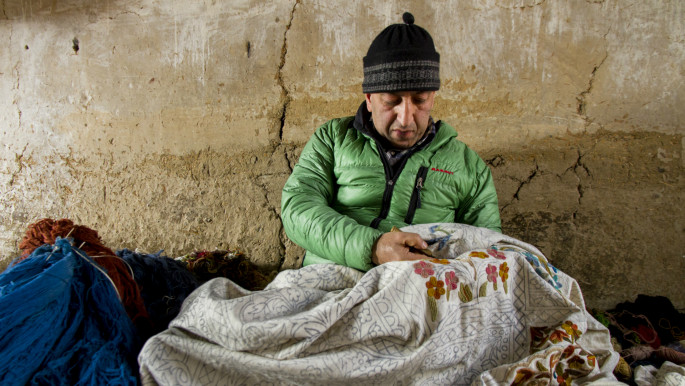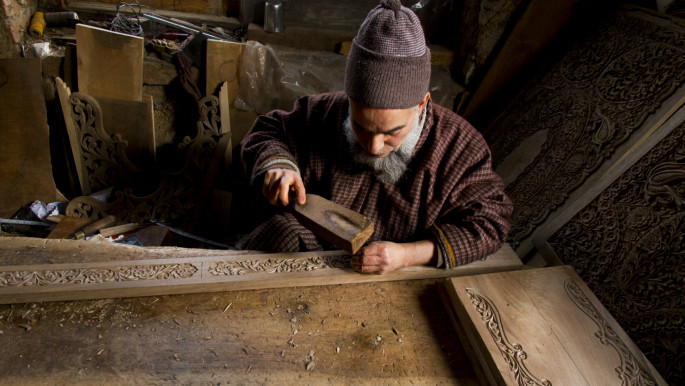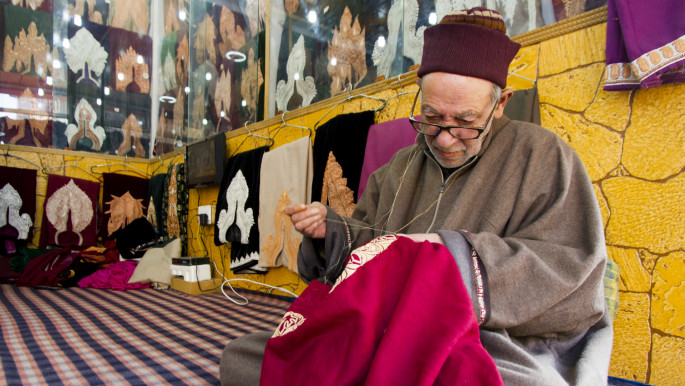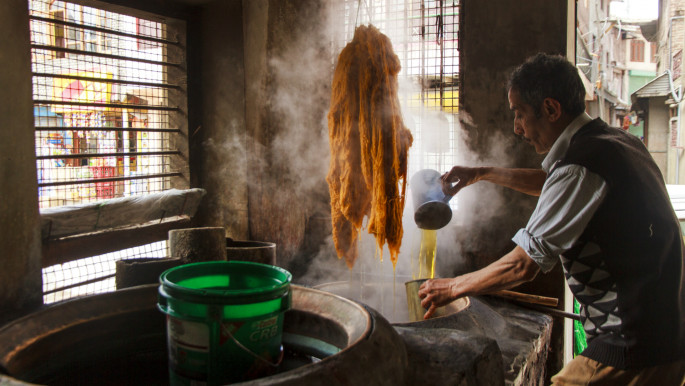
Srinagar: The city of craftsmen
Srinagar: The city of craftsmen
Photoblog: Introducing the artwork of Srinagar city.
4 min read
A craftsman living in the downtown, on an average fetch around $6 per day (Author)
One of the oldest cities of the subcontinent, Srinagar, the city of wealth, is known for its intriguing and distinctive art and architecture. Located in the foothills of the giant Himalayas and surrounded by glittering bodies of water and lush forests, the city seemingly came into existence almost 2,000 years ago.
Natives of the city continue to live along the banks of Jhelum River.
Historically, the inhabitants of Srinagar have been self-reliant, possessing a variety of skills - many of which they learnt from the architect Syed Ali Hamdani who arrived from Hamadan in the 1370s and radically changed Kashmir - religiously, socially and economically.
With the British departure from South Asia and the Kashmir territory coming into the control of India, the self-sustainability of the city has helped its denizens stand against Indian rule for decades. The city is influential for playing an active role in resistance politics since the 1990s.
Artworks found in Srinagar include handicraft, embroidery, papier-mâché, wood carving, rug-weaving and stone carving. The making of fur caps (karakulis) is also popular, having arrived here from its Central Asian roots, via Iran and neighbouring countries, during the Shahmiri Dynasty that ruled Kashmir from the 14th century to the mid-16th century.
A craftsman living downtownmakes an average of $6 per day. The lack of a policy framework and seeming disinterest of central government in regard to preserving the traditional craftsmen has led to the downfall of artworks, including woolen namdaas, pottery and pashmina.

Forty-nine-year-old Mohammad Sultan Rather fills in a velvet fabric with a design inside his workshop in Srinagar's Kawdara district. The crewel embroidery of Kashmir is hand-sewn with an awl and is locally named aari ka'em ["work of small pointed hook"].
The products are commonly used in family homes as curtains, cushions and pillows - and the artwork is different from cotton or silk embroidery. "Since crewel products are used locally and continuously I earn a good living from this work," he says.

Fayaz Ahmad Sheikh, 58, has been a wood-carver for almost 45 years. He hails from Srinagar's Fateh Kadal neighbourhood. His walnut wood carving is ornamental and a delicate craft process unique to the Kashmir region, as walnuts grow here in huge numbers.
A variety of motifs are delicately designed, depending on the usage of the item. In local parlance the artwork is known as doon hachi ka'em while the artisans are called naqash.
"My products are in high demand these days, and I am happy with my work," he says. Photo by Hilal Ahmad.

An award-winning artist, 57-year-old Syed Maqbool Hasan works in Srinagar's downtown on a papier-mâché artefact. Papier-mâché is a traditional artwork found widely in Kashmir. The skill of drawing motifs was brought to Kashmir centuries ago from Central Asia, when hundreds of artists from Samarkand relocated to Kashmir, bringing their art with them.

Mubarak Shah, in his early 80s, has been creating embroidery needlework for the past five decades.
He is from Srinagar's Aali Kadal and has mastered the art of stitching the thin layers of copper-zari designs on traditional gowns known as pherans. The hand-embroidery work is called telli lag'un and such traditional gowns are used by women during winters.
Shah says these days he only earns a few dollars a day, which he spends on cigarettes and personal expenses.

Needle weaver Ali Mohammad Dar, in his 40s, from downtown Kawdoer, started weaving kani shawl sixteen years ago. The work of weaving with the help of needle in local parlance is named tujji-ka'em.
It was introduced to Kashmir in the 15th century by then-ruler Zain-ul-Abidin. The pattern of geometry and calligraphic motifs are first drawn roughly on paper. The weaving of kani shawl [lit: "small sticks work"] usually follows an arithmetical graph and is a complex artwork.
"An artisan can fetch around $400 per shawl which he can complete within 5-12 months depending upon the designs and material. But the shawl industry has decayed here years ago," Day says.

Mohammad Younis, 42, from Srinagar's Bohri Kadal - famously known as Rangar - was a child when he learned from his father the work of giving natural and synthetic hues to different thread.
He says that his forefathers also used to do the same work, which involves the art of applying dyes to different forms of threads that are traditionally used in carpets and rugs made in Kashmir.
Umer Beigh and Hilal Ahmed are photojournalists in Kashmir
Natives of the city continue to live along the banks of Jhelum River.
Historically, the inhabitants of Srinagar have been self-reliant, possessing a variety of skills - many of which they learnt from the architect Syed Ali Hamdani who arrived from Hamadan in the 1370s and radically changed Kashmir - religiously, socially and economically.
With the British departure from South Asia and the Kashmir territory coming into the control of India, the self-sustainability of the city has helped its denizens stand against Indian rule for decades. The city is influential for playing an active role in resistance politics since the 1990s.
Artworks found in Srinagar include handicraft, embroidery, papier-mâché, wood carving, rug-weaving and stone carving. The making of fur caps (karakulis) is also popular, having arrived here from its Central Asian roots, via Iran and neighbouring countries, during the Shahmiri Dynasty that ruled Kashmir from the 14th century to the mid-16th century.
A craftsman living downtownmakes an average of $6 per day. The lack of a policy framework and seeming disinterest of central government in regard to preserving the traditional craftsmen has led to the downfall of artworks, including woolen namdaas, pottery and pashmina.

Forty-nine-year-old Mohammad Sultan Rather fills in a velvet fabric with a design inside his workshop in Srinagar's Kawdara district. The crewel embroidery of Kashmir is hand-sewn with an awl and is locally named aari ka'em ["work of small pointed hook"].
The products are commonly used in family homes as curtains, cushions and pillows - and the artwork is different from cotton or silk embroidery. "Since crewel products are used locally and continuously I earn a good living from this work," he says.

Fayaz Ahmad Sheikh, 58, has been a wood-carver for almost 45 years. He hails from Srinagar's Fateh Kadal neighbourhood. His walnut wood carving is ornamental and a delicate craft process unique to the Kashmir region, as walnuts grow here in huge numbers.
A variety of motifs are delicately designed, depending on the usage of the item. In local parlance the artwork is known as doon hachi ka'em while the artisans are called naqash.
"My products are in high demand these days, and I am happy with my work," he says. Photo by Hilal Ahmad.

An award-winning artist, 57-year-old Syed Maqbool Hasan works in Srinagar's downtown on a papier-mâché artefact. Papier-mâché is a traditional artwork found widely in Kashmir. The skill of drawing motifs was brought to Kashmir centuries ago from Central Asia, when hundreds of artists from Samarkand relocated to Kashmir, bringing their art with them.

Mubarak Shah, in his early 80s, has been creating embroidery needlework for the past five decades.
He is from Srinagar's Aali Kadal and has mastered the art of stitching the thin layers of copper-zari designs on traditional gowns known as pherans. The hand-embroidery work is called telli lag'un and such traditional gowns are used by women during winters.
Shah says these days he only earns a few dollars a day, which he spends on cigarettes and personal expenses.

Needle weaver Ali Mohammad Dar, in his 40s, from downtown Kawdoer, started weaving kani shawl sixteen years ago. The work of weaving with the help of needle in local parlance is named tujji-ka'em.
It was introduced to Kashmir in the 15th century by then-ruler Zain-ul-Abidin. The pattern of geometry and calligraphic motifs are first drawn roughly on paper. The weaving of kani shawl [lit: "small sticks work"] usually follows an arithmetical graph and is a complex artwork.
"An artisan can fetch around $400 per shawl which he can complete within 5-12 months depending upon the designs and material. But the shawl industry has decayed here years ago," Day says.

Mohammad Younis, 42, from Srinagar's Bohri Kadal - famously known as Rangar - was a child when he learned from his father the work of giving natural and synthetic hues to different thread.
He says that his forefathers also used to do the same work, which involves the art of applying dyes to different forms of threads that are traditionally used in carpets and rugs made in Kashmir.
Umer Beigh and Hilal Ahmed are photojournalists in Kashmir



